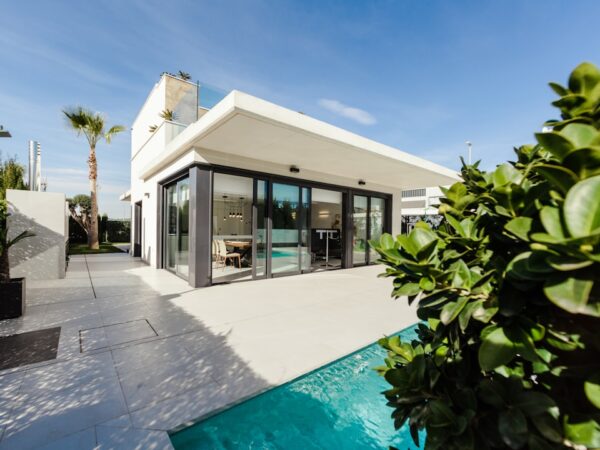
Real Estate Trends to Watch Out for in 2021: From Virtual Tours to Sustainable Living
The real estate industry is constantly evolving, with new trends and changes shaping the way properties are bought, sold, and lived in. Staying up-to-date with these trends is crucial for real estate professionals and consumers alike, as it allows them to make informed decisions and adapt to the ever-changing market. In this article, we will explore some of the current trends in the real estate industry and their impact on the market.
Key Takeaways
- Virtual tours have become increasingly popular in the real estate industry.
- The pandemic has had a significant impact on real estate markets, with a shift towards remote work and sustainable living.
- Smaller, more affordable homes are becoming more popular among buyers.
- Homebuyers are increasingly looking for outdoor spaces and home offices.
- Technology plays a crucial role in real estate transactions, with the growth of smart home technology and the expansion of co-living and co-working spaces.
- Multigenerational living is on the rise, and location remains a crucial factor in real estate investment.
The Rise of Virtual Tours in Real Estate
Virtual tours have become increasingly popular in the real estate industry, allowing potential buyers to explore properties from the comfort of their own homes. These virtual tours provide a 360-degree view of the property, giving viewers a realistic sense of the space and layout. They also often include additional features such as floor plans, interactive maps, and detailed descriptions.
The COVID-19 pandemic has accelerated the adoption of virtual tours in real estate. With social distancing measures in place, many buyers are hesitant to visit properties in person. Virtual tours offer a safe alternative, allowing buyers to narrow down their options before scheduling physical visits. Real estate agents have also embraced virtual tours as a way to showcase properties to a wider audience, including international buyers.
Several successful implementations of virtual tours have emerged in recent years. For example, Zillow offers a feature called Zillow 3D Home that allows sellers to create virtual tours of their properties using just a smartphone. This has made it easier for sellers to market their homes and attract potential buyers. Another example is Matterport, a company that specializes in creating immersive 3D virtual tours for real estate listings. Their technology has been widely adopted by real estate professionals and has proven to be an effective tool for showcasing properties.
The Impact of the Pandemic on Real Estate Markets
The COVID-19 pandemic has had a significant impact on real estate markets around the world. One of the most notable changes is the shift in buyer and seller behavior. Many buyers are now prioritizing larger homes with more outdoor space, as they seek to create a comfortable and functional living environment. On the other hand, some sellers are choosing to hold off on listing their properties due to economic uncertainty.
There has also been a shift in demand for certain types of properties. With remote work becoming more prevalent, there is an increased demand for homes with dedicated office spaces. Homebuyers are looking for properties that can accommodate their work-from-home needs, whether it be a separate room or a converted space. Additionally, there has been an increased interest in properties located in suburban areas, as people seek more space and privacy.
The pandemic has also had an impact on pricing and inventory. In some areas, prices have remained stable or even increased due to high demand and limited supply. However, in other areas, prices have declined as sellers become more motivated to sell. Inventory levels have also fluctuated, with some markets experiencing a shortage of available properties while others have seen an increase in listings.
The Emergence of Sustainable Living in Real Estate
| Metrics | Description |
|---|---|
| LEED Certification | A rating system that evaluates the environmental performance of a building and encourages sustainable design. |
| Energy Efficiency | The reduction of energy consumption through the use of efficient appliances, lighting, and HVAC systems. |
| Water Conservation | The reduction of water usage through the use of low-flow fixtures, rainwater harvesting, and greywater systems. |
| Green Roofs | A vegetative layer on the roof that provides insulation, reduces stormwater runoff, and improves air quality. |
| Renewable Energy | The use of solar, wind, or geothermal energy to power a building and reduce reliance on fossil fuels. |
| Waste Reduction | The reduction of waste through recycling, composting, and the use of sustainable materials. |
Sustainable living has become a priority for many buyers and renters in recent years. This trend is driven by a growing awareness of environmental issues and a desire to reduce one’s carbon footprint. Sustainable living encompasses various practices and features that promote energy efficiency, water conservation, and the use of eco-friendly materials.
Buyers and renters are increasingly looking for homes and communities that incorporate sustainable features. These features can include solar panels, energy-efficient appliances, rainwater harvesting systems, and green building materials. Sustainable communities often offer amenities such as community gardens, bike-sharing programs, and electric vehicle charging stations.
One example of a successful sustainable living community is Serenbe, located just outside of Atlanta, Georgia. Serenbe is designed with sustainability in mind, featuring energy-efficient homes, organic farming practices, and a commitment to preserving green space. The community also offers a range of amenities, including walking trails, a wellness center, and farm-to-table restaurants.
The Shift towards Smaller, More Affordable Homes
In recent years, there has been a shift towards smaller, more affordable homes. This trend is driven by several factors, including changing demographics, rising housing costs, and a desire for a simpler lifestyle. Smaller homes are often more affordable and require less maintenance, making them an attractive option for first-time homebuyers and downsizers.
There are several benefits to living in a smaller home. Smaller homes typically have lower utility costs and require less energy to heat and cool. They also often have a smaller environmental footprint, as they use fewer resources during construction and operation. Additionally, smaller homes can promote a sense of community, as residents are more likely to interact with their neighbors and participate in shared spaces.
One example of a successful small home community is Pocket Neighborhoods in the United States. These communities consist of clusters of small homes arranged around shared green spaces or courtyards. The homes are designed to be energy-efficient and promote a sense of community. Pocket Neighborhoods have gained popularity among those seeking a more sustainable and affordable housing option.
The Increasing Demand for Outdoor Spaces and Home Offices
The COVID-19 pandemic has influenced a growing trend towards outdoor spaces and home offices. With many people spending more time at home, there is an increased desire for outdoor areas that can be used for relaxation, recreation, and socializing. Homebuyers are looking for properties with spacious yards, patios, or balconies that can serve as extensions of their living space.
Similarly, the pandemic has highlighted the importance of having a dedicated home office or workspace. With remote work becoming more common, many people need a designated area where they can focus and be productive. Homebuyers are now prioritizing properties that offer flexible spaces that can be used as home offices or study areas.
There are several benefits to having outdoor spaces and home offices. Outdoor spaces provide opportunities for fresh air, exercise, and connection with nature. They can also be used for entertaining guests or enjoying hobbies such as gardening or outdoor cooking. Home offices, on the other hand, provide a dedicated space for work, reducing distractions and improving productivity.
One example of successful outdoor space design is the High Line in New York City. The High Line is a public park built on a historic elevated railway track. It features landscaped gardens, seating areas, and art installations, providing residents and visitors with a unique outdoor experience. As for home offices, many properties now offer flexible spaces that can be easily converted into workspaces, such as a spare bedroom or a nook in the living room.
The Importance of Technology in Real Estate Transactions
Technology has played a significant role in making real estate transactions more efficient and convenient. From online listings to digital signatures, technology has streamlined the buying and selling process, saving time and reducing paperwork. Real estate professionals are increasingly using technology to market properties, communicate with clients, and manage transactions.
One example of technology used in real estate transactions is online listing platforms such as Zillow and Realtor.com. These platforms allow buyers to search for properties based on their preferences and view detailed information and photos. They also provide tools for scheduling showings, contacting agents, and submitting offers.
Another example is the use of virtual reality (VR) technology in real estate. VR allows potential buyers to virtually walk through a property and experience it as if they were there in person. This technology provides a more immersive experience than traditional photos or videos and can help buyers make more informed decisions.
In the future, we can expect to see further developments in real estate technology. For example, blockchain technology has the potential to revolutionize property transactions by providing a secure and transparent way to record and transfer ownership. Artificial intelligence (AI) and machine learning can also be used to analyze market data and predict trends, helping buyers and sellers make more informed decisions.
The Growth of Smart Home Technology
Smart home technology has become increasingly popular in recent years, allowing homeowners to control various aspects of their homes through their smartphones or voice commands. Smart home devices can include thermostats, lighting systems, security cameras, and appliances. These devices can be connected to a central hub or controlled individually.
There are several benefits to living in a smart home. Smart home technology can improve energy efficiency by allowing homeowners to monitor and control their energy usage. For example, smart thermostats can learn the homeowner’s preferences and adjust the temperature accordingly, saving energy and reducing utility costs. Smart home devices can also enhance security by providing remote access to surveillance cameras and alarm systems.
One example of successful smart home implementation is the Google Nest system. Google Nest offers a range of smart home devices that can be controlled through a central hub or smartphone app. These devices include thermostats, cameras, doorbells, and speakers. The Google Nest system allows homeowners to create a connected and automated home environment that is tailored to their preferences.
The Expansion of Co-Living and Co-Working Spaces
Co-living and co-working spaces have gained popularity in recent years as people seek more flexible and affordable living and working arrangements. Co-living spaces are communal living environments where residents share common areas such as kitchens, living rooms, and bathrooms. Co-working spaces are shared workspaces where individuals or businesses can rent desks or offices.
There are several benefits to co-living and co-working spaces. Co-living spaces provide an opportunity for residents to build a sense of community and share resources such as utilities and household chores. They also often offer amenities such as gyms, laundry facilities, and social events. Co-working spaces provide a flexible and cost-effective alternative to traditional office spaces, allowing individuals and businesses to work in a collaborative and inspiring environment.
One example of a successful co-living and co-working space is The Collective in London. The Collective offers fully furnished apartments with shared kitchens and living spaces, as well as co-working spaces, gyms, and social areas. The community is designed to foster collaboration and connection among residents, with regular events and workshops.
The Rise of Multigenerational Living
Multigenerational living has become increasingly popular in recent years, with multiple generations of a family choosing to live together under one roof. This trend is driven by several factors, including rising housing costs, changing family dynamics, and a desire for intergenerational support and companionship.
There are several reasons for the rise in popularity of multigenerational living. For some families, it is a financial decision, as sharing expenses can help reduce the burden of housing costs. For others, it is a cultural or familial tradition, as many cultures have a long history of multigenerational living. Additionally, multigenerational living can provide emotional support and companionship for all family members, especially older adults who may benefit from the care and assistance of younger generations.
One example of successful multigenerational living communities is the Villages at Cabrillo in Long Beach, California. The Villages at Cabrillo offers affordable housing options for veterans and their families, including multigenerational units that accommodate multiple generations under one roof. The community provides a range of services and amenities to support the unique needs of multigenerational families.
The Importance of Location in Real Estate Investment
Location is one of the most important factors to consider when making a real estate investment. The location of a property can have a significant impact on its value and potential for appreciation. Factors such as proximity to amenities, schools, transportation, and job opportunities can all influence property values.
Properties located in desirable neighborhoods or areas with high demand tend to have higher property values and appreciate at a faster rate. For example, properties located in urban areas with access to public transportation and amenities such as restaurants, shops, and parks are often more sought after. Similarly, properties located in areas with good schools and low crime rates are often more desirable for families.
One example of successful real estate investments based on location is the High Line in New York City. The High Line is a public park built on a historic elevated railway track. The development of the High Line has led to an increase in property values in the surrounding area, as it has become a popular destination for residents and tourists alike.
The real estate industry is constantly evolving, with new trends and changes shaping the way properties are bought, sold, and lived in. Staying informed and adaptable is crucial for real estate professionals and consumers alike, as it allows them to make informed decisions and navigate the ever-changing market. From virtual tours to sustainable living, smaller homes to smart home technology, the real estate industry is experiencing a range of trends that are reshaping the way we live and invest in properties. By staying up-to-date with these trends, we can make the most of the opportunities available in the real estate market.
If you’re interested in staying healthy and maintaining optimal cardiovascular well-being, you might want to check out this informative article on preventive health from Wave Magnets. It emphasizes the importance of taking proactive measures to protect your heart and prevent cardiovascular diseases. With insights and tips on lifestyle changes, exercise routines, and dietary choices, this article serves as a valuable resource for anyone looking to prioritize their heart health. To learn more, click here.
FAQs
What are the current real estate trends?
The current real estate trends include a shift towards suburban living, an increase in demand for outdoor spaces, and a rise in virtual home tours and online transactions.
Why is there a shift towards suburban living?
The shift towards suburban living is due to the COVID-19 pandemic, which has caused many people to prioritize larger living spaces and outdoor areas over city living.
What is driving the demand for outdoor spaces?
The demand for outdoor spaces is being driven by the pandemic, as people are spending more time at home and want to have access to fresh air and nature.
How has technology impacted the real estate industry?
Technology has impacted the real estate industry by making virtual home tours and online transactions more common, as well as providing data and analytics to help buyers and sellers make informed decisions.
What impact has the pandemic had on the real estate market?
The pandemic has caused a shift in priorities for many buyers, leading to an increase in demand for larger living spaces and outdoor areas. It has also led to a rise in virtual home tours and online transactions.


















